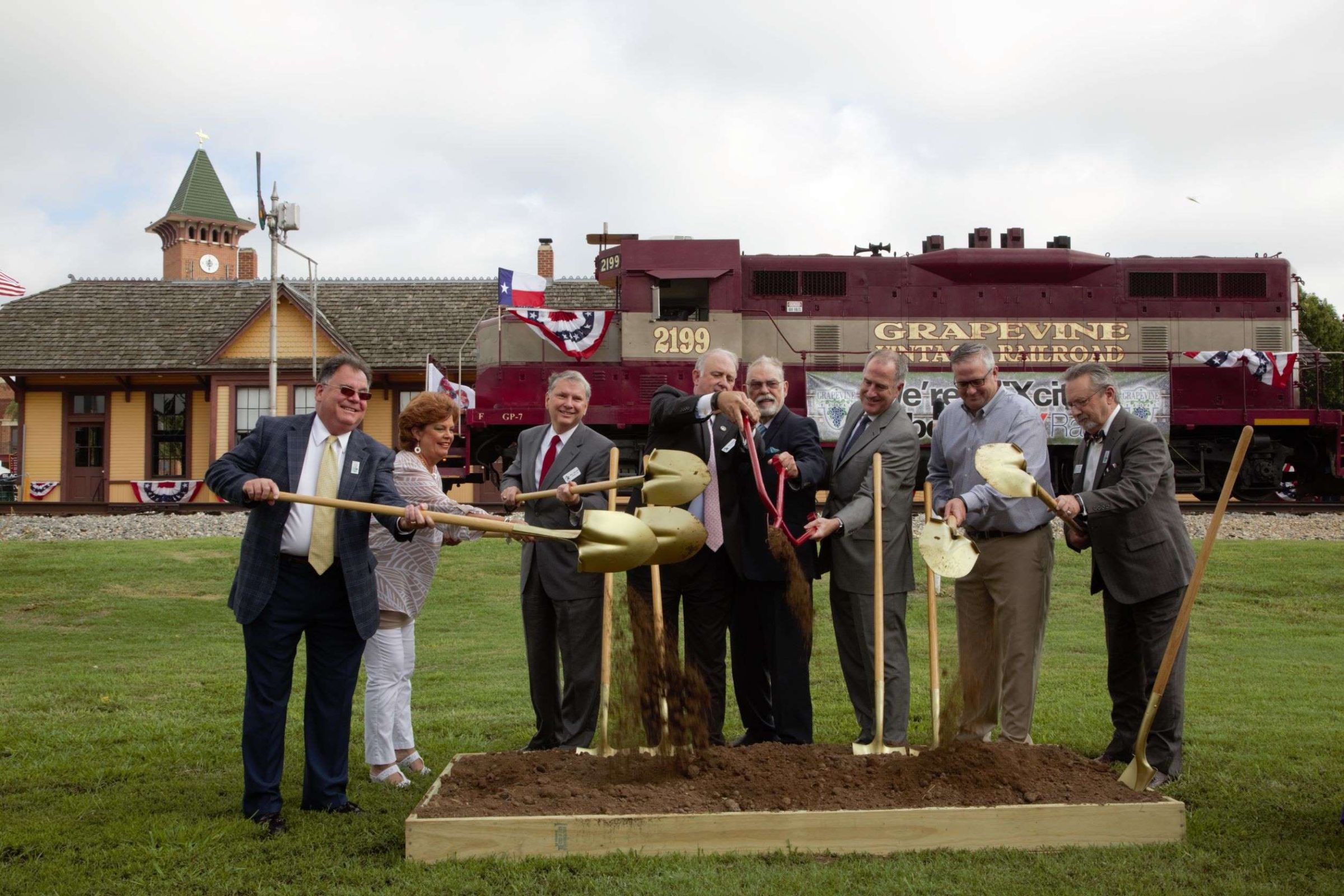Urban Rail Drives Development in Grapevine’s Historic District

2 Jul 2025
Blog, News
This Fall will mark the five-year anniversary of Hotel Vin. The attached European-style food hall, Harvest Hall, will reach the same milestone in February of next year. But the most consequential anniversary – and maybe the most likely to be overlooked – falls later in the calendar: November 2026, twenty years after a public vote that set Grapevine’s Historic District on course for intense growth.
For most of the intervening time, residents’ decision to approve a half-cent sales tax allocation in support of urban rail probably seemed inconsequential. The first passenger trains wouldn’t arrive in town for twelve years; the only signs of their impending presence a pile of dirt moving slowly in the 800 block of South Main Street and, briefly, the sound of train horns blaring as part of a mandatory testing period after a decade of silence.
Until that point, the Cotton Belt Line was used exclusively for Vintage Railroad excursions and freight shipments. Historic steel beams cut through the heart of the City, but precious few locals could make use of them. Now, a portion of every sale made in Grapevine – 3/8 of a cent covering service expenses for the operator, Trinity Metro, and the final 1/8 cent funding ongoing development – helps bring new customers to town.
But measuring this community’s return on investment goes well beyond ridership counts.
How Rail Delivered One of Grapevine’s Most Iconic Partnerships
Today, Grapevine Main Street Station is one of nine stops along a 27-mile route connecting downtown Fort Worth to DFW International Airport. More stations are planned in the near future, including a tenth stop in the Fort Worth Medical District that was part of the original system design but scrapped from the minimum operating segment to keep the project on pace. Next year, the DART Silver Line will tie into Grapevine, doubling the length and number of stops within the commuter rail ecosystem. But from its earliest inception, City leaders wanted Grapevine’s station to stand out among its peers.
“Over 70% of the people wanted us to have TEXRail,” said Councilwoman Sharron Rogers. “The City of Grapevine was the lynchpin of making that happen, because we were between Fort Worth and the Airport – or between Fort Worth and going on to Plano, McKinney, and other points to the Northeast, which is the ultimate plan as I understand it – so they were going to locate a train station somewhere here in Grapevine. We identified that site, but we did not want just a train station like we had seen in other areas, where you’ve got this little covered device with kind of a half-moon roof and that’s all it is. We wanted a depot.”

According to City Manager Bruno Rumbelow, leaders within the City seized the vision of an upscale stop and combined it with another long-term dream: to place a hotel in the middle of the Historic District.
“Really, all you need for a commuter rail is a ticket machine, a parking lot, and a way – safely – for them to get on the train, right?” he said. “We wanted a whole lot more than that. Which led us back to an idea that had been percolating for a long time about how it would be great to have a downtown hotel. That’s how it started. That land was purchased, some of the money was already allocated through Trinity Metro, and we built the parking garage first because you had to have parking to be ready for commuter rail when that service arrived. Really, I guess it was Harvest Hall and the train station next, and then the Vin.”
In the end, Hotel Vin opened before the food hall; both overcoming a pandemic slowdown to outperform their business plan projections in the first year. Before either vendor opened their doors, however, the vision shared between private operators and City planners helped to shape the rest of the system. Main Street Station remains one of the busiest stops along the entire line, sometimes topping even the international airport in total riders disembarking.
“Grapevine did their homework,” said Jeff Davis, chair of the Trinity Metro board. “They went out and looked at different stations and successes. Their food court is just awesome, and their hotel is awesome as well… they knew what they were doing twenty years ago, and the fruition is right here, right now, today. You can see what they’ve accomplished, and that’s what urban rail does… frankly, we use North Richland Hills and Grapevine as an example of what it can do for a community.”
Decision-makers say the partnership between those cities may have saved the project.
Making Ends Meet with North Richland Hills
Westbound riders can move from Grapevine to North Richland Hills in fifteen minutes or less, arriving at Smithfield Station roughly ten minutes faster than they would by driving. The convenience of that direct connection has made the neighboring stations one of the most popular pairs in the entire system. Without an agreement between the two municipalities, neither Smithfield Station nor the next stop at Iron Horse would have been included in the route.
“North Richland Hills wanted to participate, but they didn’t have any allocation of their sales tax available. We still had that half-cent we had left unallocated,” said Grapevine’s now-retired Mayor Pro Tem Darlene Freed. “[Those funds] are restricted through the government of Texas, so we offered to cover that cost for a certain period of years before they would begin to pay us back for that. So we covered the cost of North Richland Hills in order to participate with Trinity Metro.”

“Half of that project was paid for with Federal transit funds,” said Rumbelow. “In terms of the stations, that was a working out process with us, with the airport, and with the City of Fort Worth – and, later in the process – with North Richland Hills… their ridership, their participation, was critically important. That, ultimately, was going to get us to the numbers we needed in order to fully qualify for the New Starts funding; for half the capital project being paid for by the Federal government.”
TEXRail came with a ten-figure price tag, making Federal funds critically important in a State the focuses most transportation dollars on roads and highways. While every partnering City contributes toward the cost of the system, grant funds made the design and construction process an easier lift. And, more importantly, the addition of two stops in the middle of the route made the project more viable as a true urban rail segment.
“Without the two NRH stations, it would be a pretty fractured system. I think Grapevine realized that, and was able to work with North Richland Hills and Trinity Metro to make it a reality and allow us to be partners,” said Tito Rodriguez, a North Richland Hills City Council member who also serves as Vice Chair of the Trinity Metro Board. “We are great regional partners, and I think you can say that about a lot of the communities in Northeast Tarrant County. People will say ‘aren’t you jealous that Grapevine has the Hotel Vin, Tolbert’s, and Peace Plaza?’ No. It’s a compliment to them, but also it’s an opportunity for our residents to enjoy those amenities.”
Now that the City of North Richland Hills has adjusted their budget to include their required sales tax allocation, the system is healthier and more sustainable… and the City of Grapevine is being repaid for covering the gap. But that’s not the only way this community is benefitting from its initial investment.
Rebounding… and Then Some
Foot traffic estimates from Placer.ai suggest that Main Street was the first corridor in all of Grapevine to surpass pre-COVID visitation counts after the pandemic shutdown. Anonymized sales tax data for the area indicates a correlating rise in visitor spend: most months saw revenue doubled in 2024 compared to 2018, with a few improving by even larger margins. Admittedly, there are several factors at play in those numbers: inflation has generally resulted in higher gross sales for businesses across the country, and the station brought new vendors online with it.
But if we’re talking about impact, shouldn’t Harvest Hall and Hotel Vin – projects made possible by the TEXRail planning process – count toward the final tally?
“It’s everything for a transit-oriented community to be able to have early planning with the City; it’s everything to have a great partnership with your transit agency and do it together. What they did in Grapevine, with the City Manager, Bruno, and the Mayor, and P.W. McCallum; they just did a super job in planning and organizing what they wanted for their station,” said Davis, whose lifelong commitment to public transportation gives him a unique perspective even beyond his position as the board chair at Trinity Metro. “It’s really important to understand that this is a billion-dollar project and it was finished on time and under budget. Nobody has ever done that in the history of the FTA. You don’t complete projects of a billion dollars on time and under budget.

“You must acknowledge the success economically, but if you dig a little deeper and ask those folks along Main Street how well they’re doing since the train started and you’ll find out their business has doubled and tripled, directly as a result of having an incredible service. Call it a commuter line, call it whatever you want. It’s trying to move people between communities and activity centers, and it creates economic opportunity.”
The area immediately around the development is growing, too. Private developers have cautioned that long-term projects take years to get off the ground, so it may be some time before the entire neighborhood transforms, but a batch of for-sale townhomes immediately South of the hotel are indicative of a broader trend: major projects like Grapevine Main tend to spur follow-on development.
“Had it not been for the City’s investment in Harvest Hall, Grapevine Main Station, and Hotel Vin, this lot would have not been as compelling,” said Greg Gifford, Managing General Partner of NuCiti Capital Partners and mastermind behind the Grapevine Brownstones, a collection of 28 luxury single-family dwellings that were the first private project to adopt a special design standard for the area.
“That’s the reason we were able to justify choosing that location and choosing that product type. Justifying the economics and giving it a go. You know, land value is always a function or a proportion of the end product: if the end product can be developed where it supports that land value, then it can work. But you’ve got to go through the exercise to figure that out. And then you have to go through City approvals to get authorization to build that kind of a product. So we bought the Phase 1 land in ’22, but we envisioned the development as early as ’19 and 2020… it took, between the epiphany and the product, about four years. And that’s not uncommon in the development business, you know? You’re creating a product that doesn’t otherwise exist.”
Most of the Brownstones presold before construction was complete, with buyers ranging from seasoned travelers who craved airport access to families looking to downsize in their Empty Nest phase. Gifford expects his buyers to be part of the fabric of downtown life for years to come. It’s a key component of his sales pitch… and an important supplement to nearby business strategies.
This is part two of a three-part miniseries on Grapevine Main, so be sure to return for a closer look at our partnership with Coury Hospitality and the unique, local-facing business plan at Hotel Vin. For a more in-depth understanding of this project, check out ‘Growing Grapevine’ on Spotify, Apple Podcasts, or your favorite audio streaming service. You can also subscribe to our monthly newsletter or find us on Facebook and LinkedIn to stay up to date on major developments around the City.
More Topics

Smart Insights on Smart Cities
Jul 2 2025






